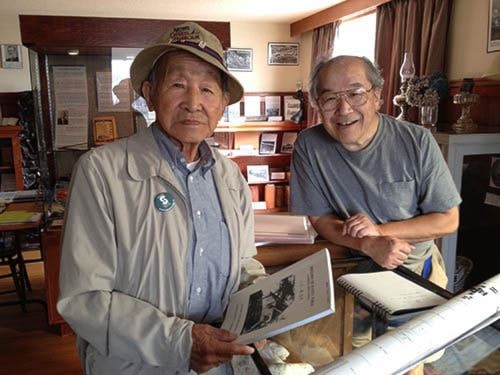By Val Patenaude
Stony Nakano and his nephew Dana Oikawa visited at the Maple Ridge Museum recently.
It was not their first visit, but the continuation of a dialog that began a few years ago. When we parted then, Stony promised he was going to send us a copy of his story and that is what he has done.
Stony was born in Ruskin in 1921, where his family had settled in 1919 after spending a few years at Britannia Beach. His father bought a piece of the Gilchrist homestead that was located on Parker Road [now 280th], where Ruskin Park is today.
The family expanded to include nine children and they grew up farming that 10-acre piece of land.
Like so many other Japanese families, they grew strawberries, but later added several chicken houses, which Stony has strong memories of cleaning before breakfast.
The children all attended school, but would usually be pulled out before the end of the year to help pick strawberries.
Stony’s whole family worked on the farm and he estimates that their net income was less $1,000 a year.
They grew most of their own food and with blue jeans at $1.35 a pair and bread at 15 loaves for a dollar, he remembers a reasonably happy life.
It was a life with little in the way of leisure time. After English school on Tuesdays and Fridays, and all day Saturday, the children attended Japanese school. During the summer holidays, one whole month was spent at Japanese school.
As the children got older, the eldest took jobs off the farm, while the younger ones took over the farm work.
At 17, Stony got a job with Kamimura Logging. The wages earned by Stony and his older brother, Koichiro, mostly went back into the farm, particularly for trucks and other equipment.
In 1938, tragedy struck the family when Stony’s mother died of tuberculosis. Kiyoko, the eldest of the girls, took over the mother role and raised the younger children, the youngest of whom was still an infant.
In 1941, the Nakano family’s world was rocked again by the news of the attack on Pearl Harbour. Nothing would be the same after that.
In May 1942, Stony, his father Rikima and two of his brothers were told to report to Hastings Park. After being housed in a cow barn for a week, Stony and his brothers were sent to a road camp west of Revelstoke. His father, who was in his mid-50s at the time, was allowed to return home. A short while later, Rikima and the rest of the family were told to vacate their house so that a Scottish family could move in.
For a time, they lived in one of the outbuildings on the farm. However, they were soon sent to another Japanese farm to help bring in the harvest, leaving behind the house and land and everything they’d worked for forever.
Stony’s father was devastated.
After the harvest was finished, Stony’s father and the rest of the family were sent to the Tashme internment camp, where the children could be housed and Rikima worked in a sawmill and helped cut firewood for the camp.
Meanwhile, Stony recounts a life of moving around the country from job to job – working everything from road crews to sugar beets to logging outfits to cattle farms.
He was 21 years old when the internment began and he saw it as a life of mobility and adventure that would not have been available to him if he had stayed in Ruskin, even though every move required the permission of the B.C. Security Commission and proof that he had a job to go to.
As he says in the conclusion to his story, “Although the evacuation took much from us, those four years during the war of travelling from job to job, seeing many places and making many friends provided me with a learning experience that I will always cherish.”
– Val Patenaude is director of the Maple Ridge Museum.
